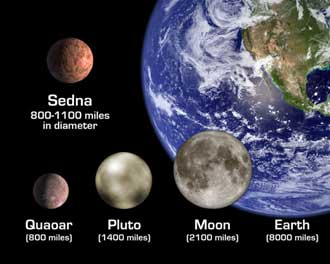Sedna is the most distant known body in the solar system. It is very dark and lonely there. Sedna is a mysterious and interesting body that has fascinated astronomers for years.
Artistic Image of Sedna Photo Source
What Is Sedna?
Sedna is one of the transneptunian objects that orbit the sun beyond Neptune in an extremely cold area of the solar system. Scientists believe that it originated from the early solar system. Its mysterious behavior and appearance could help us learn more about the beginning of the solar system.
Is Sedna a Planet?
Sedna is not a true planet because it has no moon, it is very small, and has a strange orbit that is highly elliptical. So far there are only eight planets in the solar system.
Why Is Sedna’s Orbit So Strange?
One of the things that make Sedna an interesting planet is its highly elliptical orbit that sometimes takes it very far away from the sun. Scientists have tried to explain what causes this strange orbit.
One theory attributes this to the effect of passing stars. There are also speculations that a large body, the size of Mars, or even larger orbiting at about 70 AU distance from Sedna is responsible for the highly elliptical orbit.
Why Is It Called Sedna?
Because it is so cold, dark, and distant, Sedna was named after the Inuit goddess of the sea, who was believed to live at the bottom of the Arctic Ocean.
Does Sedna Rotate on Its Own Axis?
Sedna rotates on its own axis at a very slow speed. We know that it rotates because some advanced telescopes have computed its brightness and found that it varies at different times, which is a sign of a rotating body.
It takes between 20-50 days to complete one rotation. Scientists believed this slow rotation was caused by the gravitational pull of a moon on Sedna but we now know this is not the case because it does not have a moon. Why Sedna rotates so slowly remains a mystery.
How Big Is Sedna?
Sedna is bigger than an asteroid but smaller than a planet. Observed through powerful telescopes, Sedna appears as a tiny point of light. It is not possible to measure its size directly.
Sedna is so small that even the Spitzer telescope couldn’t detect its heat output. A thermal telescope had to be used to measure its distance. By observing Sedna through powerful telescopes, Scientists have determined that it must be 1700km (1000miles) in diameter and between Pluto and Quaoar in size.
Artist’s Concept of Sedna in relation to other bodies in the solar system Image Source: NASA
Is It Possible To See Sedna?
Being so far away and dark, it is not possible to spot Sedna with the unaided eye. It takes a powerful telescope and skills to be able to view it. It is even hard for amateur astronomers to spot it. However, the first confirmation of its existence was made in an amateur observatory.
What Is Sedna Composed of?
We are not sure what it is made up of yet but its relatively bright surface indicates it might have a layer of water and methane ice on its surface.
How Does Sedna Look Like?
Sedna is one of the red objects in the solar system just like mars. Scientists don’t know why it has a reddish appearance.
Does Sedna Have a Moon?
Since Sedna rotates very slowly on its own axis, astronomers believed it had a moon that slowed down its rotation. However, pictures captured by the Hubble Space Telescope revealed this is not the case as no moon was visible.
How Far away is Sedna?
Sedna is the most distant known object orbiting the sun. It is located after Neptune and beyond the Kuiper Belt. Scientists believe it resides in the inner Oort Cloud. This is the coldest region of our solar system. Small icy objects and comets that strike the earth are found here. It is believed to be the first object in this region to be discovered.
It is 13 billion km (8 billion miles) away from the sun. From its surface, the sun appears as a tiny bright point smaller than the head of a pin. It takes 10,500 years to complete one orbit around the sun. Its orbit is highly elliptical and it approaches the sun once per orbit.
How Was Sedna Discovered?
In 2004, NASA-funded scientists studying space through a telescope discovered a mysterious planet like body orbiting the sun. They labeled it object 2003VB12 and later named it Sedna.
What Is Sedna Composed of?
Being very far away from the sun, it is natural to assume that Sedna’s surface would be composed of ice. However, this does not appear to be the case because it is just relatively bright.
So far, we know that it is red and there is no water or methane ice on its surface. Other than this, its exact composition remains a mystery.


